Refine listing
Actions for selected content:
1413 results in Ebooks in network science
13 - Use of Pathway Vectors
- from II - Mathematical Properties of Reconstructed Networks
-
- Book:
- Systems Biology
- Published online:
- 05 February 2015
- Print publication:
- 26 January 2015, pp 221-232
-
- Chapter
- Export citation
2 - Network Reconstruction: The Concept
- from I - Network Reconstruction
-
- Book:
- Systems Biology
- Published online:
- 05 February 2015
- Print publication:
- 26 January 2015, pp 17-32
-
- Chapter
- Export citation
16 - Functional States
- from III - Determining the Phenotypic Potential of Reconstructed Networks
-
- Book:
- Systems Biology
- Published online:
- 05 February 2015
- Print publication:
- 26 January 2015, pp 264-276
-
- Chapter
- Export citation
Index
-
- Book:
- Systems Biology
- Published online:
- 05 February 2015
- Print publication:
- 26 January 2015, pp 510-531
-
- Chapter
- Export citation
4 - Metabolism in Escherichia coli
- from I - Network Reconstruction
-
- Book:
- Systems Biology
- Published online:
- 05 February 2015
- Print publication:
- 26 January 2015, pp 50-74
-
- Chapter
- Export citation
29 - Epilogue
-
- Book:
- Systems Biology
- Published online:
- 05 February 2015
- Print publication:
- 26 January 2015, pp 467-480
-
- Chapter
- Export citation
20 - Equivalent States
- from III - Determining the Phenotypic Potential of Reconstructed Networks
-
- Book:
- Systems Biology
- Published online:
- 05 February 2015
- Print publication:
- 26 January 2015, pp 327-341
-
- Chapter
- Export citation
22 - Environmental Parameters
- from IV - Basic and Applied Uses
-
- Book:
- Systems Biology
- Published online:
- 05 February 2015
- Print publication:
- 26 January 2015, pp 359-377
-
- Chapter
- Export citation
10 - Simple Topological Network Properties
- from II - Mathematical Properties of Reconstructed Networks
-
- Book:
- Systems Biology
- Published online:
- 05 February 2015
- Print publication:
- 26 January 2015, pp 172-183
-
- Chapter
- Export citation
14 - Randomized Sampling
- from II - Mathematical Properties of Reconstructed Networks
-
- Book:
- Systems Biology
- Published online:
- 05 February 2015
- Print publication:
- 26 January 2015, pp 233-248
-
- Chapter
- Export citation
IV - Basic and Applied Uses
-
- Book:
- Systems Biology
- Published online:
- 05 February 2015
- Print publication:
- 26 January 2015, pp 357-358
-
- Chapter
- Export citation
24 - Analysis of Omic Data
- from IV - Basic and Applied Uses
-
- Book:
- Systems Biology
- Published online:
- 05 February 2015
- Print publication:
- 26 January 2015, pp 398-406
-
- Chapter
- Export citation
1 - Introduction
-
- Book:
- Systems Biology
- Published online:
- 05 February 2015
- Print publication:
- 26 January 2015, pp 1-14
-
- Chapter
-
- You have access
- Export citation
List of abbreviations
-
- Book:
- Systems Biology
- Published online:
- 05 February 2015
- Print publication:
- 26 January 2015, pp xvii-xviii
-
- Chapter
- Export citation
5 - Prokaryotes
- from I - Network Reconstruction
-
- Book:
- Systems Biology
- Published online:
- 05 February 2015
- Print publication:
- 26 January 2015, pp 75-95
-
- Chapter
- Export citation
23 - Genetic Parameters
- from IV - Basic and Applied Uses
-
- Book:
- Systems Biology
- Published online:
- 05 February 2015
- Print publication:
- 26 January 2015, pp 378-397
-
- Chapter
- Export citation
8 - Metastructures of Genomes
- from I - Network Reconstruction
-
- Book:
- Systems Biology
- Published online:
- 05 February 2015
- Print publication:
- 26 January 2015, pp 134-148
-
- Chapter
- Export citation
27 - Model-driven Design
- from IV - Basic and Applied Uses
-
- Book:
- Systems Biology
- Published online:
- 05 February 2015
- Print publication:
- 26 January 2015, pp 438-450
-
- Chapter
- Export citation

Models of Life
- Dynamics and Regulation in Biological Systems
-
- Published online:
- 05 October 2014
- Print publication:
- 02 October 2014
References
-
- Book:
- Models of Life
- Published online:
- 05 October 2014
- Print publication:
- 02 October 2014, pp 301-333
-
- Chapter
- Export citation
